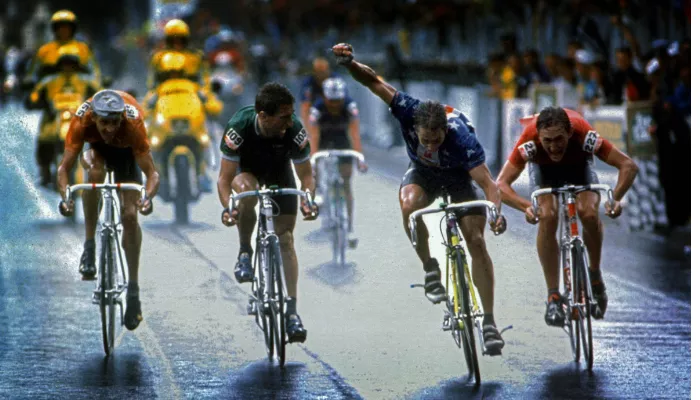In 1981, my introduction to the sport of cycling began with the Tour de France, but it was soon followed by the World Championships, largely thanks to American cyclist Greg Lemond. His impressive silver medal at the 1982 race in Goodwood, England, at just 21 years old, and his groundbreaking victory in Altenrhein, Switzerland, the following year solidified my annual anticipation for the pursuit of the rainbow jersey. However, it was his unforgettable victory in 1989 that stands out as my favorite World Championship—a race many consider the most thrilling one-day event in cycling history.
In late September 1989, I was starting my junior year at the University of Oregon. Lemond had just claimed victory in the Tour de France that July, marking one of the sport’s most dramatic comebacks and igniting excitement within the cycling community. Amid the buzz of his Tour triumph, news reached my circle of cycling friends—via slow print media, as there was no internet at the time—that Lemond had won the World Road title in Chambery, France, at the end of August. Situated in the French Alps, Chambery was just thirty miles from Albertville, the recent host of the Winter Olympics. Unfortunately, we were unable to verify this information until our VeloNews magazine arrived.
One evening, while studying at my desk, my training partner Mike Keep called, breathless with excitement: “The Worlds is on TV, there are only a few laps left—get over here!” I quickly hopped on my bike and sprinted three blocks to Mike’s place, thrilled at the prospect of watching the race. Unlike my setup, Mike had a large color TV and cable, and his friend Darrol Batke, a member of the National Team, had alerted him that ESPN was airing an hour of the event. Just five weeks after the gripping Tour, the race promised to be incredibly challenging, featuring 21 laps of a 7.7-mile circuit that totaled 162 miles with nearly 20,000 vertical feet of climbing. The Côte de Montagnole, averaging 7.25% over 2.5 miles, served as the primary obstacle. To heighten the drama, a mid-race thunderstorm brought heavy rain, making it one of the toughest World Championships since the legendary 1980 race in Sallanches, France, where only fifteen riders finished.
The first major break occurred on the fourteenth lap, led by French climber Thierry Claveyrolat, Dutch cyclist Maarten Ducrot, Swiss rider Thomas Wegmüller, and Russian Dmitri Konyshev, who had pulled 3:40 ahead of the remaining competitors. Claveyrolat was powering up the climb, while Konyshev appeared relaxed and in control. By the next lap, Ducrot had dropped back, forcing Konyshev to bridge the gap back to Claveyrolat. With intense efforts from the Spanish team, American Andy Hampsten led the charge as the penultimate lap began, while Frenchman Laurent Fignon and Dutchman Steven Rooks positioned themselves at the front of the chase group.
As the gap narrowed to just 40 seconds, Rooks attacked on the final climb, closing the distance significantly and ultimately joining Claveyrolat and Konyshev on the descent. Meanwhile, Irishman Martin Earley led a select group of nine chasers, including notable names like Claude Criquelion, Steve Bauer, Gianni Bugno, Marino Lejarreta, Rolf Sørenson, Fignon, and Lemond. The last ascent would be decisive.
Approaching the final climb, the gap widened to 35 seconds as the chasing group slowed. When the grade steepened, Fignon made his move, and Earley faltered. The gap shrank to 15 seconds as Fignon climbed smoothly, rapidly closing in on the leaders. Commentators Phil Liggett and Brian Drebber kept viewers on edge, speculating about Fignon’s potential to exact revenge for his earlier loss in the Tour.
When coverage resumed, Lemond surged from the chasing group, quickly catching up to Fignon. “And Greg Lemond has made his move!” Liggett exclaimed, as Lemond swiftly overtook Fignon, escalating the pace. As they neared the summit, Lemond surged ahead, with Claveyrolat grabbing his wheel as they sped down the descent.
With just three miles to go, the tension was palpable. Fignon bridged the gap, while Bauer suffered a puncture at a critical moment. Fignon attacked again but faced fierce competition from Lemond, who led the chase at a blistering 55 miles per hour through the rain. As Lemond, Claveyrolat, and Fignon engaged in tactical maneuvers, the stakes continued to rise.
As they entered the final kilometer, Fignon made another aggressive move on the inside. Lemond responded immediately, positioning himself strategically for the final sprint. In a dramatic finish, Lemond emerged victorious, clinching his second World title and joining an elite group of riders who had won both the Tour de France and the World Championship in the same year—an accomplishment that remains unmatched to this day.
Lemond’s incredible performance, marked by tactical brilliance and resilience, defined the 1989 World Championship and solidified its place in cycling lore as one of the most thrilling races in history.
Related topics:
- RFU Faces Crisis as Schools Rugby Declines, Warns Review
- French Transport Minister to Meet Cycling Groups After Cyclist’s Death Provokes Protests
- Facing Mortality: Chris Hoy’s Perspective on Terminal Illness

